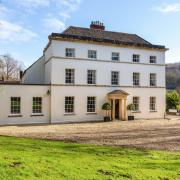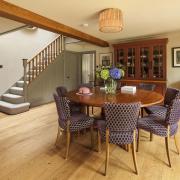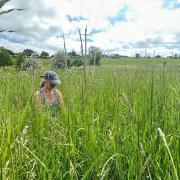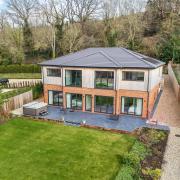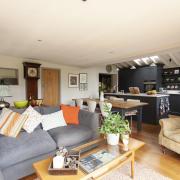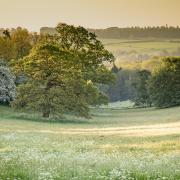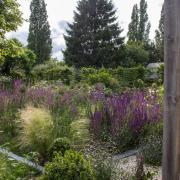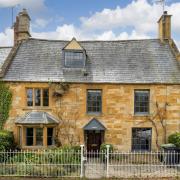There’s an unexpected informality to the gardens at Asthall Manor. Words and pictures by Mandy Bradshaw
There’s a constrained wildness about the gardens at Asthall Manor, at odds with what a Cotswold manor house often offers.
The usual formal layout is blurred by rambling plants, large areas are gardened with only the lightest touch, and even the topiary is huge, rearing ‘waves’ rather than neatly clipped balls.
‘It's as wild as it can be within the structure that's needed to make it a garden,’ says owner Rosie Pearson.
‘I see gardening as a sort of negotiation with Nature and you've got to listen to what it's saying. So, there are times when you knock it into shape and there are other times when you let it tell you what it wants to do.’


This approach means plants, such as geranium and astrantia, are allowed to self-seed, and mullein is tolerated as part of the garden’s eco system because it feeds caterpillars that in turn are food for birds.
‘We will go in and control, softly and delicately where we need to, to maintain the look whilst keeping a guiding hand on it,’ added head gardener Owen Vaughan.
The most formal elements are around the rose-clad house – once home to the Mitford sisters – which Rosie bought 22 years ago.


Mounds of scabious, Alchemilla mollis and lavender add a curved edge to an otherwise straight gravel path, leading on to low box hedges hemming borders that are filled with billowing plants, such as Hydrangea arborescens ‘Annabelle’, dianthus and roses.
‘It’s just crammed full of beautiful plants that are aimed to peak in midsummer,’ says Owen.
Since my last visit to Asthall, the ‘zig zag bed’ has been planted up. Part of the original garden design by Isabel and Julian Bannerman – who number Prince Charles and the Rothschilds among their clients – it had never been completed.

Owen has removed an old, overgrown pyracantha that dominated the space and added more plants, although he shied away from making it purely philadelphus as the Bannermans suggested – ‘It would be absolutely fantastic but I just wanted a few more plants in there.’
There are some, including an unusual small-leaved, evergreen variety, P. palmeri, which gets to only around 45cm tall but is covered in scented flowers.
One place where Nature did get an unwanted upper hand is the parterre, which was badly hit by box blight.
The team tried to rescue the plants and cut them to the ground to encourage new growth, spraying with a foliar feed and improving the soil around with a green manure.
‘We did everything we could,’ says Owen, but eventually they admitted defeat and the parterre has been removed.
In its place is a mix of wildflowers, repeating the style seen in other areas of the garden, while yew and beech domes set into the wildflowers provide a link to the nearby yew topiary.
The domes need to mature so that they will rise out of the wildflowers but already it’s looking better than the blight-hit box.
The wildflower areas are a notable feature of Asthall and have been increased in recent years, particularly in the lower part of the garden leading down to a stream on the furthest boundary.
Originally planted with an annual seed mix, these are being left to return to more traditional ‘hay meadow’ areas. The annual flowers are disappearing, and the grass is being controlled by the introduction of more yellow rattle.

The areas are cut gradually, one at a time, with the team ensuring they leave a ‘wildlife corridor’ rather than cutting it all back at once.
Meanwhile, creating a giant haystack at the end of the season has solved the problem of how to get rid of the grass when the access isn’t suitable for a tractor and trailer. The resulting compost is reused in the garden, some of it in the Walled Garden where a new community crop share scheme has been launched.
Under the guidance of food grower Tim Mitchell, the area is gradually being turned into a no dig fruit and vegetable garden. For a small subscription, local people can pick up boxes of produce in a smaller scale, more rustic box scheme.
‘It's very low fuss,’ explains Tim. ‘There are no food miles and if volunteers come, there's always some stuff for them to take away.’
Run organically like the rest of the garden, it has a wildlife pond and a ‘dead hedge’ made of prunings to encourage beneficial predators in, and a polytunnel and greenhouse to help extend the growing season.


With Rosie now unable to forage freely in the Walled Garden, Owen has introduced more vegetable plants into the border that disguises the tennis court. For many years, this was always just sweet peas growing up the net fence but plants now include peas, sweetcorn, chard – the seedlings individually selected for the best colour – beetroot and beans.
‘Everything in this border, except the sweet peas is going to be edible.’
Nearby, a natural swimming pool replaces the traditional version with plants along the edges. The family now enjoy the water alongside toads and newts.


Behind the colonial-style changing rooms, is one of Asthall’s more unusual features – huge earth mounds whose undulating shapes mimic the surrounding Cotswold hills.
The first was created from the spoil from the swimming pool and Owen jokes that every head gardener since has added another.
They subtly link the more formal garden and the wilder areas beyond and make a great setting for the sculpture in Asthall’s well known ‘on form’ exhibition, which is held every other year.
More unusual are a group of three tree ferns: ‘They’re not very sustainable,’ admits Rosie, ‘but they're just irresistible.’
They are certainly a startling sight, just visible above an earth mound and set into a hay meadow.
‘It’s something that you don't really expect in a traditional Cotswold garden,’ says Owen. ‘We like to challenge people's perspectives and ideas.’


One area that is in his sights for developing is around a small manmade pool where ferns and moss-covered rocks under mature copper beech, horse chestnuts and sycamores, create a cool, green oasis with a small hermitage and wood-burning stove proving a popular spot for visitors to linger.
Further along the stream, the planting is kept deliberately semi-wild with yellow flag iris, purple loosestrife, and meadowsweet, while Darmera peltata is used rather than gunnera because Owen believes the smaller leaves are a better fit.
‘There’s a delicate balance between ornamental and wild,’ says Owen. ‘The whole idea of the garden is it’s meant to be very wild, very free-growing and link into the fields and landscape around us.’
For more information, visit asthallmanor.com





